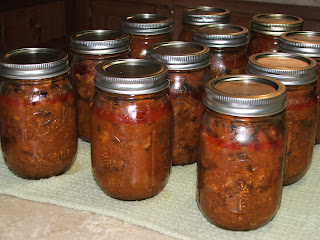I am from Western North Carolina... lived there all my life... and then I moved... to the Midlands of South Carolina three years ago. I love my job here, the people are so wonderful. Winters are mild here. Spring is beautiful, the flowers are gorgeous. It's really a nice place... and my life is better than ever...
But...
There are a few things I REALLY miss about my former lifelong home... it's flat here, sometimes I really miss my mountains... it's HOT here in the summer, and humid... and the barbecue here is... well... to put it politely... it's not to my liking... (*whispers* it's yucky)
Where I come from barbecue is almost a religion... and it's red... and slightly sweet, with a little vinegary flavor...
Here barbecue is eaten, loved by many... and it's yellow... mustard based... they think that's normal... they actually like it that way! THEY don't know any better...
I recently bought two nice Boston Pork Butts on sale at my local grocery store... it was time to make some REAL barbecue!
Boston
butt is a cut of pork that
comes from the upper part of the shoulder from the front leg and may contain
the blade bone. In the US, smoked or barbecued Boston butt is southern tradition.
In pre-revolutionary New England and
into the American Revolutionary War, some pork cuts (not those highly
valued, or "high on the hog,"
like loin and ham) were packed into casks or barrels (also known as
"butts") for storage and shipments. The way the hog shoulder
was cut in the Boston area became
known in other regions as "Boston butt." In the UK it is known
as "pork hand and spring," or simply "pork hand."
There are many ways to cook pork butt... it can be slow roasted in the oven, wrapped in aluminum foil and baked, put in the slow cooker... we decided to smoke ours this time... Mmmm!
After cooking, I pulled the pork (hence the name, "pulled pork") from the bone, removed all the fat and gristle, chopped, and shredded it. (Smokey Dog enjoyed the fat, gristle, and bone... over a period of several meals)
Then I made my homemade barbecue sauce with...
1-3/4 cups ketchup
1/4 cup prepared mustard
1/4 cup brown sugar
1/4 cup apple cider vinegar
1/2 Tbsp. garlic powder
1 tsp. black pepper
1/2 oz. liquid smoke
1 oz. Worcestershire sauce
1 oz. hot sauce (I used Louisiana brand)
1/2 Tbsp. lemon juice
Since I was barbecuing two butts... I doubled the above recipe, except for the liquid smoke... since the meat was already smoked AND liquid smoke tends to intensify when canned, I left it at 1/2 ounce.
Any good barbecue sauce would work with this process, bottled, your own recipe, someone else's recipe... it's all a matter of taste.
I mixed my sauce in with the pulled pork... it seemed a little dry for canning... I wanted my pork to be completely submerged in the sauce... so I added some water until I got the consistency I was looking for (I added about 2-3 cups of water).
I brought the meat/sauce mixture to a simmer... meanwhile I prepared my pint canning jars by boiling them in water... and I put my lids in simmering water to sterilize and kept them all hot until I was ready for them.
Again, a matter of taste... the pulled pork could be canned without sauce, adding the sauce after opening or used in other pork recipes... broth or water could be added to the jars of pork instead of the BBQ sauce.
I ladled the hot barbecue into the hot jars...
I wiped the jar rims with a damp cloth to remove any residue... dipping the cloth in a little vinegar helps to remove any grease that might have been left on the jar rim.
I removed the lids from the simmering water using my handy dandy magnetic lid wand, tightening them onto the jars to a fingertip tightness.
I processed the jars in my pressure canner at 10 pounds of pressure for 70 minutes (90 minutes for quart jars).
After processing, I removed the canner from the heat and let it cool, and allowing the pressure to drop naturally (don't hurry it or it might result in broken jars and ruined barbecue!)... then I removed the canner lid...
...and removed the jars from the canner using my jar lifter... and set them on a folded dish towel on the counter to cool... and to listen for the PING of each successfully sealed jar.
Ahhh... real barbecue any time I want it... RED... like barbecue is supposed to be!
































